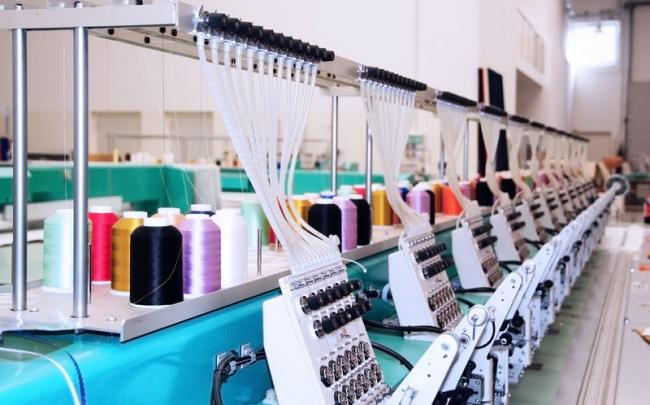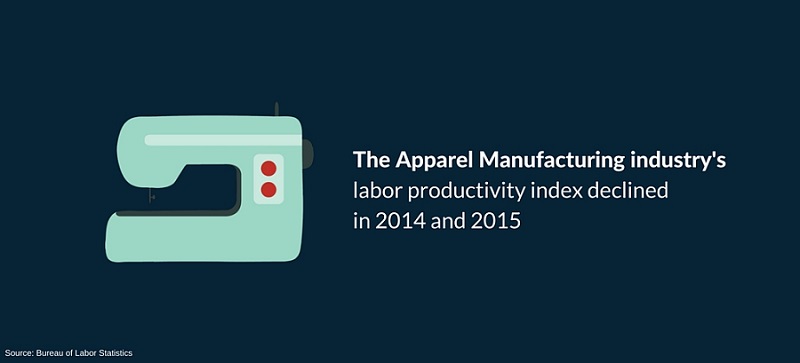Topics
What is Apparel Lean Manufacturing? How New Tech Can Streamline Your Garment Business

Apparel lean manufacturing holds the promise of increasing productivity, reducing cycle time, reducing lead time, eliminating manufacturing waste, improving product quality and ultimately improving profitability. Yet the Bureau of Labor Statistics reported that the labor productivity index for the Apparel Manufacturing industry declined year-over-year in 2014 and in 2015.[1] So how can apparel, fashion and footwear companies achieve lean manufacturing?
Sewn products manufacturers must constantly improve upon product quality, production speed and operational efficiency to keep pace in a competitive industry. Apparel lean manufacturing, which results in lower production costs, increased output and minimized production times, may be the answer.

What is lean manufacturing?
Lean manufacturing, also referred to as lean production, is a systematic approach to achieving highly efficient factory or plant operations through eliminating waste. The original seven types of waste are defined as:
- Transport (moving products that are not actually required to perform the processing)
- Inventory (all components, work in process, and finished product not being processed)
- Motion (people or equipment moving or walking more than is required to perform the processing)
- Waiting (waiting for the next production step, interruptions of production during shift change)
- Overproduction (production ahead of demand)
- Over Processing (resulting from poor tool or product design creating activity)
- Defects (the effort involved in inspecting for and fixing defects) [2]
This strategy, which was borne of the Japanese Toyota Production System, requires a continuous pursuit of performance improvement by defining “value” as any action or process that a customer is willing to pay for.[1] Operational and cost efficiency can be achieved through several means:
- Eliminating unnecessary waste, including but not limited to time loss, excessive raw material inputs and preventable defects
- Reducing lead and cycle times
- Reducing inventory levels at every stage of production
- Improving workforce productivity
- Optimizing use of equipment and space [3]
The goal is to improve plant or factory systems by eliminating manufacturing waste and inefficiency.
Lean manufacturing principles
The approaches for implementing lean practices in the apparel, fashion and footwear industries vary, but the main principles of lean manufacturing are based on 5S and Kaizen.
5S is a workplace organization method comprised of five Japanese words: seiri, seiton, seiso, seiketsu, and shitsuke. The 5S methodology describes how work spaces should be organized for efficiency and efficacy. Standardization of manufacturing items used, how they should be stored, and how the items and area should be maintained help sustain the new order among workers and management alike.
5S can be translated as:
- Sort
- Set
- Shine
- Standardize
- Sustain [2]
Kaizen is the Japanese word for “improvement.” In this case, it refers to the continuous improvement of all business and workforce functions at every level.[4] In garment manufacturing, every level of production can be improved from raw materials handling to inventory.
Tools and technology
Apparel lean manufacturing requires a lean culture and the use of lean tools. Value-added activities are anything that transform materials into the product that the customer wants, and waste should be eliminated at every level from reducing work in process times, to minimizing production costs to reducing time loss. The entire plant culture needs to be involved in discussions to understand the approach and order, and certain technologies may need to be applied.
Manufacturing Shop Floor Control technology has been utilized by many of the world’s leading apparel and garment manufactures to streamline and optimize factory operations. Shop Floor Control increases labor productivity while standardizing processes and reducing time loss. Recently, there have been several new development in Shop Floor Control software that make the technology even more accessible, accurate and useful. In response to the rapid advancement in technology and the digital transformation of business, next-gen Shop Floor Control solutions are adding wireless operator apps for increased accessibility and mobility. Additionally, there is an increasing focus on providing dashboards that offer actionable intelligence; the distillation of big data and complex analytics into information that can be immediately applied to improve manufacturing operations.
Implementing lean manufacturing
Apparel and garment manufacturers may stand to gain from implementing the lean manufacturing methodology. Individual manufacturers will determine whether the shift towards lean manufacturing makes sense for their business after an initial assessment of the plant and its financials. Organization-wide discussions should be opened up regarding any systematic changes because buy-in at every level of the organization – from the executives to the line operators – is critical for the success of any change initiative. Then manufacturing goals can shift towards the systematic elimination of waste for increased productivity and improved production.
References
[1] Bureau of Labor Statistics, “Apparel manufacturing: NAICS 315,” [Online].
[2] Wikipedia, “Lean manufacturing,” [Online].
[3] M. Uddin, "Study on Lean Manufacturing Process in Garments Production," [Online].
[4] Wikipedia, “5S (methodology),” [Online]

